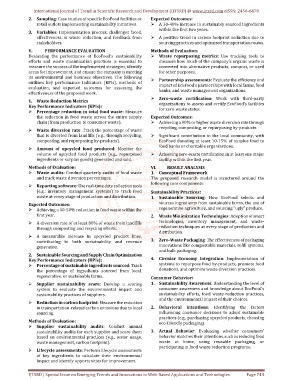Page 753 - Emerging Trends and Innovations in Web-Based Applications and Technologies
P. 753
International Journal of Trend in Scientific Research and Development (IJTSRD) @ www.ijtsrd.com eISSN: 2456-6470
2. Sampling: Case studies of specific EcoFood facilities or Expected Outcomes:
retail outlets implementing sustainability initiatives. A 30-40% increase in sustainably sourced ingredients
within the first two years.
3. Variables: Implementation process, challenges faced,
effectiveness in waste reduction, and feedback from A positive trend in carbon footprint reduction due to
stakeholders. sourcing practices and optimized transportation routes.
V. PERFORMANCE EVALUATION Methods of Evaluation:
Evaluating the performance of EcoFood’s sustainability Waste repurposing metrics: Use tracking tools to
efforts and waste minimization practices is essential to measure how much of the company’s organic waste is
measure the success of the implemented strategies, identify converted into alternative products, compost, or used
areas for improvement, and ensure the company is meeting for other purposes.
its environmental and business objectives. The following
outlines key performance indicators (KPIs), methods of Partnership assessments: Evaluate the efficiency and
evaluation, and expected outcomes for assessing the impact of EcoFood’s partnerships with local farms, food
effectiveness of the proposed work. banks, and waste management organizations.
Zero-waste certification: Work with third-party
1. Waste Reduction Metrics organizations to assess and certify EcoFood’s facilities
Key Performance Indicators (KPIs): for zero-waste status.
Percentage reduction in total food waste: Measure
the reduction in food waste across the entire supply Expected Outcomes:
chain (from production to consumer waste). Achieving a 90% or higher waste diversion rate through
recycling, composting, or repurposing by-products.
Waste diversion rate: Track the percentage of waste
that is diverted from landfills (e.g., through recycling, Significant contribution to the local community, with
composting, and repurposing by-products). EcoFood donating at least 10-15% of surplus food to
food banks or charitable organizations.
Amount of upcycled food produced: Monitor the
volume of upcycled food products (e.g., repurposed Achieving zero-waste certification in at least one major
ingredients or surplus goods) generated and sold. facility within the first year.
Methods of Evaluation: VI. RESULT ANALYSIS
Waste audits: Conduct quarterly audits of food waste 1. Conceptual Framework
and track waste diversion percentages. The proposed research model is structured around the
following core components:
Reporting software: Use real-time data collection tools
(e.g., inventory management systems) to track food Sustainability Practices:
waste at every stage of production and distribution. 1. Sustainable Sourcing: How EcoFood selects and
sources ingredients from sustainable farms, the use of
Expected Outcomes:
regenerative agriculture, and sourcing “ugly” produce.
Achieving a 40-50% reduction in food waste within the
first year. 2. Waste Minimization Technologies: Adoption of smart
A diversion rate of at least 80% of waste from landfills technologies, inventory management, and waste-
through composting and recycling efforts. reduction techniques at every stage of production and
distribution.
A measurable increase in upcycled product lines,
contributing to both sustainability and revenue 3. Zero-Waste Packaging: The effectiveness of packaging
generation. innovations like compostable materials, refill systems,
and bulk packaging.
2. Sustainable Sourcing and Supply Chain Optimization
4. Circular Economy Integration: Implementation of
Key Performance Indicators (KPIs):
systems to repurpose food by-products, promote food
Percentage of sustainable ingredients sourced: Track
donations, and optimize waste diversion practices.
the percentage of ingredients sourced from local,
regenerative, or sustainable farms. Consumer Behavior:
Supplier sustainability score: Develop a scoring 1. Sustainability Awareness: Understanding the level of
system to evaluate the environmental impact and consumer awareness and knowledge about EcoFood’s
sustainability practices of suppliers. sustainability efforts, food waste reduction practices,
and the environmental impact of their choices.
Reduction in carbon footprint: Measure the reduction
in transportation-related carbon emissions due to local 2. Behavioral Intentions: Identifying the factors
sourcing. influencing consumer decisions to adopt sustainable
Methods of Evaluation: practices (e.g., purchasing upcycled products, choosing
eco-friendly packaging).
Supplier sustainability audits: Conduct annual
sustainability audits for each supplier and score them 3. Actual Behavior: Evaluating whether consumers’
based on environmental practices (e.g., water usage, behavior matches their intentions, such as reducing food
waste management, carbon footprint). waste at home, using reusable packaging, or
participating in food waste reduction programs.
Lifecycle assessments: Perform lifecycle assessments
of key ingredients to calculate their environmental
impact and identify opportunities for improvement.
IJTSRD | Special Issue on Emerging Trends and Innovations in Web-Based Applications and Technologies Page 743

